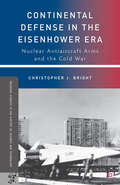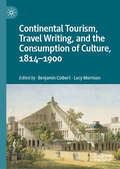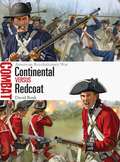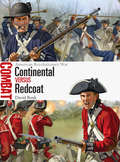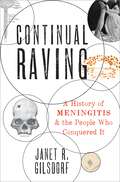- Table View
- List View
Continent by Default: The European Union and the Demise of Regional Order
by Anne Marie Le GloannecIn Continent by Default, Anne Marie Le Gloannec, a distinguished analyst of contemporary Europe, considers the European Union as a geopolitical project. This book offers a comprehensive narrative of how the European Union came to organize the continent, first by default through enlargement and in a more proactive, innovative, but not always successful way. The EU was not conceived as a foreign-policy actor, she says, and the Union was an innocent on questions of geopolitics. For readers who may wonder how the EU arrived at Brexit, the invasion of Ukraine, and the refugee crisis, Le Gloannec ties events to the EU’s long-term failure to think in politically strategic terms. Le Gloannec takes readers through the process by which, under the security umbrella of the United States, the European Commission engineered a new way for states and societies to interact. Continent by Default shows the Commission domesticated international relations and promoted peace by including new members—enlargement was the most significant tool the EU used from its inception to organize the continent, but the EU also tied itself to its regional neighbors through various programs that too often gave those neighbors the advantage. As Continent by Default makes clear, the EU cannot devise strategy because foreign policy remains the privilege of national governments. It is a geopolitical actor without geopolitical means.
Continental Defense in the Eisenhower Era: Nuclear Antiaircraft Arms and the Cold War (Palgrave Studies in the History of Science and Technology)
by C. BrightThousands of nuclear antiaircraft arms were designed, tested and deployed in the United States during Dwight D. Eisenhower's presidency. These Army "Nike-Hercules" missiles, Air Force "Genie" rockets, and "BOMARC" and "Falcon" missiles were meant to counter a raid by attacking Soviet bombers. U.S. policy makers believed that the American weapons could safely compensate for technological limitations which otherwise made it difficult to destroy high flying, fast moving airplanes. Continental Defense in the Eisenhower Era traces this armament from conception through deployment. Bright recounts official actions, doctrinal decisions, and public policies. It also discusses the widespread acceptance of these weapons by the American public, a result of being touted in news releases, featured in films and television episodes, and disseminated throughout society as a whole.
The Continental Dollar: How the American Revolution Was Financed with Paper Money (Markets and Governments in Economic History)
by Farley GrubbAn illuminating history of America’s original credit market. The Continental Dollar is a revelatory history of how the fledgling United States paid for its first war. Farley Grubb upends the common telling of this story, in which the United States printed cross-colony money, called Continentals, to serve as an early fiat currency—a currency that is not tied to a commodity like gold, but rather to a legal authority. As Grubb details, the Continental was not a fiat currency, but a “zero-coupon bond”—a wholly different species of money. As bond payoffs were pushed into the future, the money’s value declined, killing the Continentals’ viability years before the Revolutionary War would officially end. Drawing on decades of exhaustive mining of eighteenth-century records, The Continental Dollar is an essential origin story of the early American monetary system, promising to serve as the benchmark for critical work for decades to come.
The Continental Dollar: How the American Revolution Was Financed with Paper Money (Markets and Governments in Economic History)
by Farley GrubbAn illuminating history of America’s original credit market. The Continental Dollar is a revelatory history of how the fledgling United States paid for its first war. Farley Grubb upends the common telling of this story, in which the United States printed cross-colony money, called Continentals, to serve as an early fiat currency—a currency that is not tied to a commodity like gold, but rather to a legal authority. As Grubb details, the Continental was not a fiat currency, but a “zero-coupon bond”—a wholly different species of money. As bond payoffs were pushed into the future, the money’s value declined, killing the Continentals’ viability years before the Revolutionary War would officially end. Drawing on decades of exhaustive mining of eighteenth-century records, The Continental Dollar is an essential origin story of the early American monetary system, promising to serve as the benchmark for critical work for decades to come.
Continental Idealism: Leibniz to Nietzsche
by Paul ReddingStandard accounts of nineteenth-century German philosophy often begin with Kant and assess philosophers after him in light of their responses to Kantian idealism. In Continental Idealism, Paul Redding argues that the story of German idealism begins with Leibniz. Redding begins by examining Leibniz's dispute with Newton over the nature of space, time and God, and stresses the way in which Leibniz incorporated Platonic and Aristotelian elements in his distinctive brand of idealism. Redding shows how Kant's interpretation of Leibniz's views of space and time consequently shaped his own 'transcendental' version of idealism. Far from ending here, however, Redding argues that post-Kantian idealists such as Fichte, Schelling and Hegel on the one hand and metaphysical sceptics such as Schopenhauer and Nietzsche on the other continued to wrestle with a form of idealism ultimately derived from Leibniz. Continental Idealism offers not only a new picture of one of the most important philosophical movements in the history of philosophy, but also a valuable and clear introduction to the origins of Continental and European philosophy.
Continental Idealism: Leibniz to Nietzsche
by Paul ReddingStandard accounts of nineteenth-century German philosophy often begin with Kant and assess philosophers after him in light of their responses to Kantian idealism. In Continental Idealism, Paul Redding argues that the story of German idealism begins with Leibniz. Redding begins by examining Leibniz's dispute with Newton over the nature of space, time and God, and stresses the way in which Leibniz incorporated Platonic and Aristotelian elements in his distinctive brand of idealism. Redding shows how Kant's interpretation of Leibniz's views of space and time consequently shaped his own 'transcendental' version of idealism. Far from ending here, however, Redding argues that post-Kantian idealists such as Fichte, Schelling and Hegel on the one hand and metaphysical sceptics such as Schopenhauer and Nietzsche on the other continued to wrestle with a form of idealism ultimately derived from Leibniz. Continental Idealism offers not only a new picture of one of the most important philosophical movements in the history of philosophy, but also a valuable and clear introduction to the origins of Continental and European philosophy.
Continental Philosophy and Philosophy of Religion (Handbook of Contemporary Philosophy of Religion)
by Morny JoyThis is the first book that provides access to twelve Continental philosophers and the consequences of their thinking for the philosophy of religion. Basically, in the second half of the twentieth century, it has been treated from within the Anglo- American school of philosophy, which deals mainly with proofs and truths, and questions of faith. This approach is more concerned with human experience, and pays more attention to historical context and cultural influences. As such, it provides challenging questions about the way forward for philosophy of religion in the twenty-first century.
Continental Philosophy and the Palestinian Question: Beyond the Jew and the Greek (Suspensions: Contemporary Middle Eastern and Islamicate Thought)
by Zahi ZallouaFrom Sartre to Levinas, continental philosophers have looked to the example of the Jew as the paradigmatic object of and model for ethical inquiry. Levinas, for example, powerfully dedicates his 1974 book Otherwise than Being to the victims of the Holocaust, and turns attention to the state of philosophy after Auschwitz. Such an ethics radically challenges prior notions of autonomy and comprehension-two key ideas for traditional ethical theory and, more generally, the Greek tradition. It seeks to respect the opacity of the other and avoid the dangers of hermeneutic violence. But how does such an ethics of the other translate into real, everyday life? What is at stake in thinking the other as Jew? Is the alterity of the Jew simply a counter to Greek universalism? Is a rhetoric of exceptionalism, with its unavoidable ontological residue, at odds with shifting political realities? Within this paradigm, what then becomes of the Arab or Muslim, the other of the Jew, the other of the other, so to speak? This line of ethical thought-in its desire to bear witness to past suffering and come to terms with subjectivity after Auschwitz-arguably brackets from analysis present operations of power. Would, then, a more sensitive historical approach expose the Palestinian as the other of the Israeli? Here, Zahi Zalloua offers a challenging intervention into how we configure the contemporary.
Continental Philosophy and the Palestinian Question: Beyond the Jew and the Greek (Suspensions: Contemporary Middle Eastern and Islamicate Thought)
by Zahi ZallouaFrom Sartre to Levinas, continental philosophers have looked to the example of the Jew as the paradigmatic object of and model for ethical inquiry. Levinas, for example, powerfully dedicates his 1974 book Otherwise than Being to the victims of the Holocaust, and turns attention to the state of philosophy after Auschwitz. Such an ethics radically challenges prior notions of autonomy and comprehension-two key ideas for traditional ethical theory and, more generally, the Greek tradition. It seeks to respect the opacity of the other and avoid the dangers of hermeneutic violence. But how does such an ethics of the other translate into real, everyday life? What is at stake in thinking the other as Jew? Is the alterity of the Jew simply a counter to Greek universalism? Is a rhetoric of exceptionalism, with its unavoidable ontological residue, at odds with shifting political realities? Within this paradigm, what then becomes of the Arab or Muslim, the other of the Jew, the other of the other, so to speak? This line of ethical thought-in its desire to bear witness to past suffering and come to terms with subjectivity after Auschwitz-arguably brackets from analysis present operations of power. Would, then, a more sensitive historical approach expose the Palestinian as the other of the Israeli? Here, Zahi Zalloua offers a challenging intervention into how we configure the contemporary.
Continental Philosophy in the 20th Century: Routledge History of Philosophy Volume 8
by Richard KearneyContinental philosophy is one of the twentieth century's most important and challenging philosophical movements. This major volume includes fourteen chapters on its major representatives and schools, including phenomenology, existentialism and postmodernism.
Continental Philosophy in the 20th Century: Routledge History of Philosophy Volume 8 (Routledge History Of Philosophy Ser. #Vol. 8)
by Richard KearneyContinental philosophy is one of the twentieth century's most important and challenging philosophical movements. This major volume includes fourteen chapters on its major representatives and schools, including phenomenology, existentialism and postmodernism.
The Continental Risque: A captivating and stirring maritime adventure that will have you gripped (The\revolution At Sea Saga #Bk. 3)
by James NelsonThe third enthralling instalment of the Revolution at Sea seriesA powerful maritime adventure in the epic, true-to-life tradition of Patrick O'Brian.In the winter of 1776, a decade of simmering tensions finally comes to the boil. The rebel government of Philadelphia, determined to cast off the chains of British tyranny, has authorised the creation of the United States Navy - a brazen act of American aggression against the greatest maritime power in the world.Still battered from her fight in Bermudan waters, the brig-of-war Charlemagne under the command of Captain Isaac Biddlecomb sets sail on a daring mission to raid the British store of arms on New Providence Island in the Bahamas. But he finds that his greatest enemy is an undisciplined crew on the brink of mutiny, and, beset by betrayal and treachery, Biddlecomb must find a way of uniting his men against a cruel and common foe... as the British Navy prepares to sink the Charlemagne under the merciless blasts of its guns.
Continental Tourism, Travel Writing, and the Consumption of Culture, 1814–1900
by Benjamin Colbert Lucy MorrisonThis book explores the boundaries of British continental travel and tourism in the nineteenth century, stretching from Norway to Bulgaria, from visitors’ albums to missionary efforts, from juvenilia to joint authorship. The essay topics invoke new aesthetics of travel as consumption, travel as satire, and of the developing culture of tourism. Chronologically arranged, the book charts the growth and permutations of this new consumerist ideology of travel driven by the desires of both men and women: the insatiable appetite for new accounts of old routes as well as appropriation of the new; interart reproductions of description and illustration; and wider cultural manifestations of tourism within popular entertainment and domestic settings. Continental tourism provides multiple perspectives with wide-ranging coverage of cultural phenomena increasingly incorporated into and affected by the nineteenth-century continental tour. The essays suggest the coextension of travel alongside experiential boundaries and reveal the emergence of a consumerist attitude toward travel that persists in the present day.
Continental Transfers: Cultural and Political Exchange among Spain, Italy and Argentina, 1914-1945 (Studies in Latin American and Spanish History #8)
by Maximiliano Fuentes Codera and Patrizia DoglianiDespite being separated by thousands of miles and shaped by distinctive national histories, the countries of Spain, Italy, and Argentina were intertwined in a variety of ways during the first half of the twentieth century. This collection brings scholars from each nation into conversation with one another to trace these complex historical connections over the period of the two World Wars. Deploying “Latinity” as a novel analytical framework, it gives a broad and dynamic perspective on cases of reciprocal exchange that include the influence of Italian Socialism on Hispanophone leftists; the roots of Argentine liberalism in Machiavelli and Spanish Nationalist thinkers; and the web of connections among Italian Fascism, Argentine Nacionalismo, and Spanish Francoism.
Continental vs Redcoat: American Revolutionary War (Combat #9)
by Johnny Shumate David BonkThe American Revolutionary War pitched the newly formed Continental Army against the professional British Redcoats – a highly trained organization manned by long-serving and experienced infantrymen with a formidable reputation forged on European battlefields during the Seven Years' War. So, how were the poorly trained, poorly supplied Continental infantry able to hold their own and shape the outcome of the Revolutionary War and establish the future of their young nation? David Bonk answers this question in a highly illustrated book that looks at the challenges facing both armies, weighing up how each side was able to cope with the day-to-day experiences of the war and using extensive first-hand accounts to allow a modern audience to experience what life was like for soldiers on and off the battlefield during the war.
Continental vs Redcoat: American Revolutionary War (Combat #9)
by Johnny Shumate David BonkThe American Revolutionary War pitched the newly formed Continental Army against the professional British Redcoats – a highly trained organization manned by long-serving and experienced infantrymen with a formidable reputation forged on European battlefields during the Seven Years' War. So, how were the poorly trained, poorly supplied Continental infantry able to hold their own and shape the outcome of the Revolutionary War and establish the future of their young nation? David Bonk answers this question in a highly illustrated book that looks at the challenges facing both armies, weighing up how each side was able to cope with the day-to-day experiences of the war and using extensive first-hand accounts to allow a modern audience to experience what life was like for soldiers on and off the battlefield during the war.
Contingency and Freedom: Lectura I 39 (The New Synthese Historical Library #42)
by John Duns ScotusDuring the seventies, there was a revival of systematic philosophy in general and of ontology in particular. At the same time, especially in Anglo-Saxon thinking, systematic philosophy interacted very creatively with the history of medieval philosophy. It seems to us that the work of John Duns Scotus (1266-1308) could substantially benefit these develop ments. Not only this, but his works cries out to be developed across the whole spectrum of theology -that science which, in the Middle Ages, ruled all others ('regina scientiarum'). This book is the outcome of several years of scholarship and friend ship during which, guided by Dr. A. Vos, we have studied the work of Scotus. Our research group is connected to the Theological Faculty of Utrecht and to the Dutch Franciscan Study Centre (Stichting Francis caans Studiecentrum). This study presents a translation and commentary of Lectura I 39, which, in our view, is noteable as one of the key texts in the history of systematic theology and philosophy. In this book we have used specialist language and argumentation, but at the same time have taken pains to make it useful to a circle of in terested readers wider than simply that of those well-versed in medieval scholasticism. In this way, we hope to present the difficult but instruc tive work of the 'subtle master' ('doctor subtilis') in such a way as to make it attractive to other scholars and students in theology and philoso phy.
Contingency and Natural Order in Early Modern Science (Boston Studies in the Philosophy and History of Science #332)
by Pietro Daniel Omodeo Rodolfo GarauThis volume considers contingency as a historical category resulting from the combination of various intellectual elements – epistemological, philosophical, material, as well as theological and, broadly speaking, intellectual. With contributions ranging from fields as diverse as the histories of physics, astronomy, astrology, medicine, mechanics, physiology, and natural philosophy, it explores the transformation of the notion of contingency across the late-medieval, Renaissance, and the early modern period. Underpinned by a necessitated vision of nature, seventeenth century mechanism widely identified apparent natural irregularities with the epistemological limits of a certain explanatory framework. However, this picture was preceded by, and in fact emerged from, a widespread characterization of contingency as an ontological trait of nature, typical of late-Scholastic and Renaissance science. On these bases, this volume shows how epistemological categories, which are preconditions of knowledge as “historically-situated a priori” and, seemingly, self-evident, are ultimately rooted in time. Contingency is intrinsic to scientific practice. Whether observing the behaviour of a photon, diagnosing a patient, or calculating the orbit of a distant planet, scientists face the unavoidable challenge of dealing with data that differ from their models and expectations. However, epistemological categories are not fixed in time. Indeed, there is something fundamentally different in the way an Aristotelian natural philosopher defined a wonder or a “monstrous” birth as “contingent”, a modern scientist defines the unexpected result of an experiment, and a quantum physicist the behavior of a photon. Although to each inquirer these instances appeared self-evidently contingent, each also employs the concept differently.
Contingent Citizens: Shifting Perceptions of Latter-day Saints in American Political Culture
Contingent Citizens features fourteen essays that track changes in the ways Americans have perceived the Latter-day Saints since the 1830s. From presidential politics, to political violence, to the definition of marriage, to the meaning of sexual equality—the editors and contributors place Mormons in larger American histories of territorial expansion, religious mission, Constitutional interpretation, and state formation. These essays also show that the political support of the Latter-day Saints has proven, at critical junctures, valuable to other political groups. The willingness of Americans to accept Latter-day Saints as full participants in the United States political system has ranged over time and been impelled by political expediency, granting Mormons in the United States an ambiguous status, contingent on changing political needs and perceptions.Contributors: Matthew C. Godfrey, Church History Library; Amy S. Greenberg, Penn State University; J. B. Haws, Brigham Young University; Adam Jortner, Auburn University; Matthew Mason, Brigham Young University; Patrick Q. Mason, Claremont Graduate University; Benjamin E. Park, Sam Houston State University; Thomas Richards, Jr., Springside Chestnut Hill Academy; Natalie Rose, Michigan State University; Stephen Eliot Smith, University of Otago; Rachel St. John, University of California Davis
Continual Raving: A History of Meningitis and the People Who Conquered It
by Janet R. GilsdorfNot all scientific discoveries are genius. Continual Raving tells the combined stories of how scientists across the 19th and 20th centuries defeated meningitis -- not through flawless scientific research, but often through a series of serendipitous events, misplaced assumptions, and flawed conclusions. The result is a story of not just a vanquished disease, but how scientific accomplishment sometimes occurs where it's least expected. Although symptoms of meningitis were recorded as early as Hippocrates and the ancient Greeks, our understanding of the disease's origins and mechanisms remained obscure for most of human history. That changed in 1892, when German physician Richard Pfeiffer observed and isolated bacteria ultimately shown to cause meningitis in children -- and concluded that those bacteria cause influenza. Haemophilus influenzae, as thee meningitis-causing bacteria have been erroneously named ever since, continued their strange journey to discovery in the decades that followed. Continual Raving traces the disease's strange encounters with science, including: · Heinrich Quincke, the German internist who first used a needle to draw spinal fluid from between a patient's back bones · Simon Flexner's management of American meningitis epidemics using immune serum from a horse · American bacteriologist Margaret Pittman's discovery (during the Great Depression, no less) of a sugar overcoat that protects the bacteria from white blood cells · Pediatrician Ashley Weech, who gave the first antibiotic used in America (based on instructions written in German) to a young patient sick with meningitis · Microbiologist Hattie Alexander, who learned why these antibiotics sometimes fail in such patients · Four scientists, in two teams, as they vied to be the first to create the right vaccine to prevent meningitis in infants In each of these deeply human stories, variables of chance, circumstance, and incorrect assumptions intervene to shape not just the arc of the scientists' lives, but the trajectory of how humans have come to understand one of our most pernicious diseases. Continual Raving is a mosaic tale of how science conquered meningitis -- and a larger story of the sometimes winding road to discovery.
Continual Raving: A History of Meningitis and the People Who Conquered It
by Janet R. GilsdorfNot all scientific discoveries are genius. Continual Raving tells the combined stories of how scientists across the 19th and 20th centuries defeated meningitis -- not through flawless scientific research, but often through a series of serendipitous events, misplaced assumptions, and flawed conclusions. The result is a story of not just a vanquished disease, but how scientific accomplishment sometimes occurs where it's least expected. Although symptoms of meningitis were recorded as early as Hippocrates and the ancient Greeks, our understanding of the disease's origins and mechanisms remained obscure for most of human history. That changed in 1892, when German physician Richard Pfeiffer observed and isolated bacteria ultimately shown to cause meningitis in children -- and concluded that those bacteria cause influenza. Haemophilus influenzae, as thee meningitis-causing bacteria have been erroneously named ever since, continued their strange journey to discovery in the decades that followed. Continual Raving traces the disease's strange encounters with science, including: · Heinrich Quincke, the German internist who first used a needle to draw spinal fluid from between a patient's back bones · Simon Flexner's management of American meningitis epidemics using immune serum from a horse · American bacteriologist Margaret Pittman's discovery (during the Great Depression, no less) of a sugar overcoat that protects the bacteria from white blood cells · Pediatrician Ashley Weech, who gave the first antibiotic used in America (based on instructions written in German) to a young patient sick with meningitis · Microbiologist Hattie Alexander, who learned why these antibiotics sometimes fail in such patients · Four scientists, in two teams, as they vied to be the first to create the right vaccine to prevent meningitis in infants In each of these deeply human stories, variables of chance, circumstance, and incorrect assumptions intervene to shape not just the arc of the scientists' lives, but the trajectory of how humans have come to understand one of our most pernicious diseases. Continual Raving is a mosaic tale of how science conquered meningitis -- and a larger story of the sometimes winding road to discovery.
Continuation or Change? Borders and Frontiers in Late Antiquity and Medieval Europe: Landscape of Power Network, Military Organisation and Commerce
by Gregory Leighton 321 Ukasz Ró 380 Ycki Piotr PrankeThis volume examines interdisciplinary boundaries and includes texts focusing on material culture, philological analysis, and historical research. What they all have in common are zones that lie in between, treated not as mere barriers but also as places of exchange in the early Middle Ages. Focusing on borderlands, Continuation or Change uncovers the changing political and military organisations at the time and the significance of the functioning of former borderland areas. The chapters answer how the fiscal and military apparatus were organised, identify the turning points in the division of dynastic power, and assign meaning to the assimilation of certain symbolic and ideological elements of the imperial tradition. Finally, the authors offer answers to what exactly a "statehood without a state" was in regard to semi-peripheral and peripheral areas that were also perceived through the prism of the idea of a world system, network theory, or the concept of so-called negotiating borderlands. Continuation or Change is a useful resource for upper-level undergraduates, postgraduates, and scholars interested in medieval warfare, Eastern European history, medieval border regions, and cross-cultural interaction.
Continuation or Change? Borders and Frontiers in Late Antiquity and Medieval Europe: Landscape of Power Network, Military Organisation and Commerce
by Gregory Leighton Łukasz Różycki Piotr PrankeThis volume examines interdisciplinary boundaries and includes texts focusing on material culture, philological analysis, and historical research. What they all have in common are zones that lie in between, treated not as mere barriers but also as places of exchange in the early Middle Ages. Focusing on borderlands, Continuation or Change uncovers the changing political and military organisations at the time and the significance of the functioning of former borderland areas. The chapters answer how the fiscal and military apparatus were organised, identify the turning points in the division of dynastic power, and assign meaning to the assimilation of certain symbolic and ideological elements of the imperial tradition. Finally, the authors offer answers to what exactly a "statehood without a state" was in regard to semi-peripheral and peripheral areas that were also perceived through the prism of the idea of a world system, network theory, or the concept of so-called negotiating borderlands. Continuation or Change is a useful resource for upper-level undergraduates, postgraduates, and scholars interested in medieval warfare, Eastern European history, medieval border regions, and cross-cultural interaction.
Continuing the Revolution: The Political Thought of Mao (PDF)
by John Bryan StarrThe author investigates the internal logic and evolution of Mao's theory in terms of various themes. Beginning with a consideration of conflict, which in Mao's view is a given and permanent component of society, Professor Starr then takes up the individual concepts of knowledge and action, authority, class and class conflict, organization, participation and representation, political education, political history, and political development.Originally published in 1979.The Princeton Legacy Library uses the latest print-on-demand technology to again make available previously out-of-print books from the distinguished backlist of Princeton University Press. These editions preserve the original texts of these important books while presenting them in durable paperback and hardcover editions. The goal of the Princeton Legacy Library is to vastly increase access to the rich scholarly heritage found in the thousands of books published by Princeton University Press since its founding in 1905.
Continuity and Anachronism: Parliamentary and Constitutional Development in Whig Historiography and in the Anti-Whig Reaction Between 1890 and 1930 (International Archives of the History of Ideas Archives internationales d'histoire des idées #91)
by P.B.M. BlaasSeveral ofthe themes of this study have been treated in earlier publica tions, some by means of a general analysis and some through a detailed handling of problems raised by a particular theme or historian. Both the more general theoretical treatment of the theme and the concrete historiographical treatment are, I think, indispensable aids to the proper understanding of the development of historical scholarship in nineteenth-and twentieth-century England. There are a number of problems in a concrete historiographical approach: there is first the mass of historians to be faced, and then the immense amount of historical themes dealt with in various periods. As a guideline through the tangle of themes we chose the historiography on the development of the English parliament. We can only hope that we have made a responsible choice of the historians concerned. Un fortunately it was not always possible for us to give extensive biogra phies of some of the more recent historians, as several 'papers' are still firmly in the possession of families, and a number of them mus- despite of years - still be labelled 'confidential.' The Pollard Papers in the London Institute of Historical Research thus remained inaccessible. Fortunately the lack was partly compen sated by some important material being found apart from these Papers.

